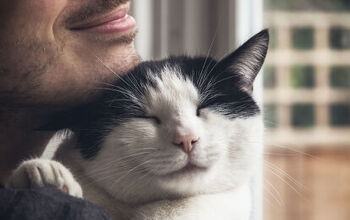This Special Camera Reveals How Our Pets See the World Around Them

Have you ever wondered how your pet sees the world around them? We all know that the eyes of dogs, cats, and all other animals are not the same as ours, and they often see the world in a very different way. While all we could do is imagine and theorize up until now, thanks to a new breakthrough in technology we will be able to take a peek through the eyes of animals!
Scientists have invented a special camera that uses a unique combination of state-of-the-art hardware and software, in order to create videos and images that show us exactly how certain animals see. For example, with this latest tech, you will be able to see the vivid world of colors that are seen through the eyes of birds and bees. One of the recent demonstrations revealed how a UV-sensitive vision of a bird renders an orange sulfur butterfly - the result is more than striking, as it doesn’t look like anything related to human vision.
Of course, we humans have very advanced eyes, and we are thus able to view the world in incredible detail, with all the sharpness and all the colors. But in the animal world, things are much different. And some animals even have better “options” than we do. For example, certain animals are able to perceive wavelengths of light that are completely invisible to the human eye. The team of scientists behind this tech was well aware of such features and tried to incorporate them into the program. Thanks to false color imagery, they were able to create representations of all those colors that animals can see.
The end result - is a versatile and dynamic technology that can translate the colorful vision of animals to our own eyes.
“The system works by splitting light between two cameras, where one camera is sensitive to ultraviolet light while the other is sensitive to visible light.” Daniel Hanley, an associate professor of biology at George Mason University and one of the authors of this study, said together with Vera Vasas, a biologist at the Queen Mary University of London. “This separation of ultraviolet from visible light is achieved with a piece of optical glass, called a beam splitter. This optical component reflects UV light in a mirror-like fashion but allows visible light to pass through just the same way as clear glass does. In this way, the system can capture light simultaneously from four distinct wavelength regions: ultraviolet, blue, green, and red.”
Thanks to their latest software, the data that is received from the special cameras is transformed into so-called “perceptual units” that correspond directly to an animal’s known photoreceptor sensitivity. And that’s where images and videos come to life - presenting the wonderful world of colors seen by the animals around us.
“The idea of recording in UV has been around for a long time now, but there have been relatively few attempts due to the technical difficulties involved in it. Interestingly, the first published UV video is from 1969!” Hanley and Vasas said in a joint statement. “Our new approach provides a valuable degree of scientific accuracy enabling our videos to be used for scientific purposes.”
Plans are already in motion to utilize this novel and groundbreaking tech to improve future nature documentaries. One of the main funders of their work was the National Geographic Society, which is working with award-winning nature photographer Neil Losin.
“We have a number of ideas that we are planning to address with our camera, but the most exciting questions will be those we have yet to consider,” Hanley and Vasas said. “Only now that we started taking videos of the natural world, we are beginning to see how much information is out there.”
To make things even better, they have utilized components that are readily available on the market, and have also made their software open-sourced. All this means so much for the future of understanding the animal world.
“We have intentionally made this all open-access specifically to encourage the research and film community to adapt and improve the system,” they said. “We believe that this will speed up the development, to everyone’s benefit.”

A proud mama to seven dogs and ten cats, Angela spends her days writing for her fellow pet parents and pampering her furballs, all of whom are rescues. When she's not gushing over her adorable cats or playing with her dogs, she can be found curled up with a good fantasy book.
More by Angela Vuckovic























